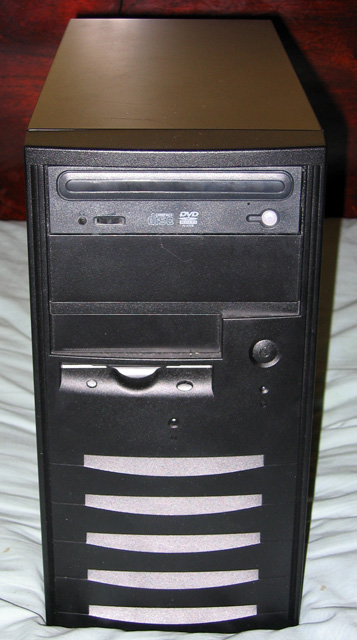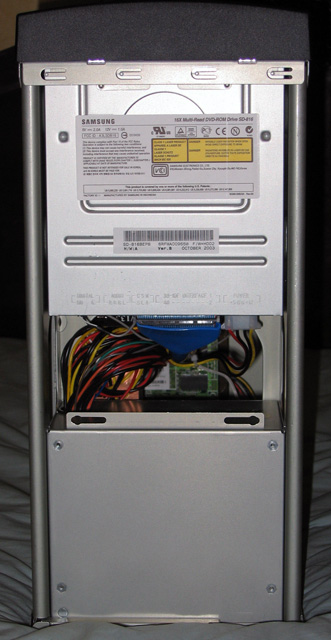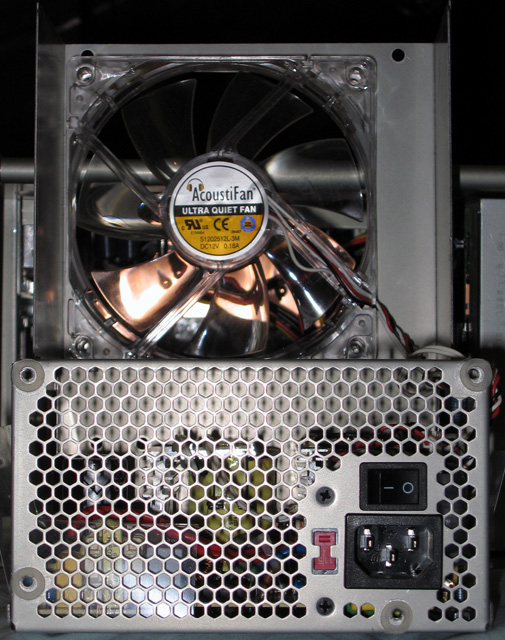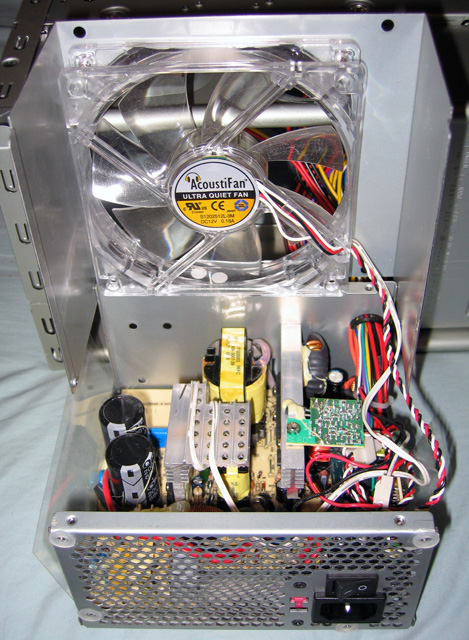
sIGMA
oNE
I've had many complaints that the window is too small, so click here to fix it.
Sigma One
represents a new developmental focus for me. Until now, NgTechnik
Design (formerly NgTech Labs) has
focused on three primary system attributes: performance, stability and
aesthetics (styling). In a departure from previous efforts, it was decided that
NgTechnik would develop a new type of system, focused specifically on a single
more important attribute: ergonomics. What you see here is the final
product of this new line focus, also indicating the name change.
First and foremost among ergonomics is
system acoustics, and in developing this system I went all-out, attacking every
single conceivable source of noise, of every single type from moving parts
resonance, to wind flow noise, to drive access noise and any other sound I
encountered. Measures taken are demonstrated here. The result of all
this work? Sigma One is so quiet, so very dead silent, that the Onkyo
TX-SR501 receiver is audible from sitting position!
Yes you read correctly: the absolutely minute buzz produced by the solid
state surround receiver of this system is faintly
audible over the sound produced by Sigma One itself.
Along with the dampeners and quiet drive selection, the
Fortron power supply unit, which ships with a relatively quiet 120mm fan, has
been extensively modified by myself, using a new, even quieter fan, the
AcoustiProducts Acoustifan AF120CT. The modifications are detailed below,
along with images and commentary.
Next in regards to personal computer ergonomics is ease of
use and controls comfort. Everything should fall to hand naturally, and
using the system should be a joy, not a pain. Because the original reason
for building a silent system was to get the absolute most out of the high-end,
high-fidelity sound system attached to this system, a tight focus on ergonomics
came into play when choosing the control setup and display type. The most
comfortable position for listening to the system is a good eight to ten feet
back from the desktop, feet up, free from the tangle of wires and the
claustrophobic atmosphere of the computer desk. To deal with this, the
Logitech Wireless Desktop MX for Bluetooth with MX900 mouse were chosen as
interface method. Bluetooth wireless technology proved to be high
performance enough, with excellent response time, and the range is sufficient to
work from anywhere within my bedroom, home to Sigma One. Another excellent
feature of Bluetooth is its compatibility with other Bluetooth-enabled devices
such as PDAs and cell phones. I am currently synching up my
Bluetooth-enabled cell phone, a Sony/Ericsson T610, to my machine and keeping an active contact database
crosslink between the cell phone and Outlook 2003. Plus this will allow me to very
quickly move to the next cell without worry of having to reprogram it all.
Finally, the display type is of critical importance to
ergonomics. To achieve the target of minimal environmental sound
production, I chose to match Sigma One up to the quietest practical display
type, a 15" LCD, or more precisely, the Samsung SyncMaster 151P. LCDs
produce much lower noise output than CRTs, such as the ViewSonic P95+ hooked up
to Alpha Three, which lets off a clearly audible buzz when the room is, all else
considered, silent. The 151P was chosen over other models because of its
stylish F.A.Porsche-designed facade and because it has digital (DVI-I) input.
The DVI input is critical in avoiding the image-destroying digital-analogue and
analogue-digital double conversion process required to hook up LCDs using
standard VGA hookup. The image is much sharper and stable than that of
analogue-connected LCDs or CRTs, and critical to a system that will be used for
long hours like Sigma-One. Please proceed to the images below, after a
brief review of specifications, to
experience Sigma-One more in-depth; if you feel the images are too cramped in
this frame,
click here to bring up this page in its own window and to make the images
larger!
Clicking on certain images on this page
will also bring the page up in its own window,
starting right at the larger version of the clicked image (this only works for
images that have larger versions).
NgTechnik Design Sigma One System Specifications:
System Foundation:
Enclosure: Black InWin
IW-V523G; side duct grills and exhaust grill removed with Wiss tin snips
Power Supply Unit: Modified
Fortron P300-60PN with AcoustiProducts 120mm Acoustifan AF120CT through included
resistor
System Mainboard:
ASUStek P4B533-VM
System Cooling: AcoustiProducts 80mm Acoustifan AF80CT through included resistor, mounted with ear grommets as exhaust
System Silencing: "Egg Crate Foam," lining top panel, side panels, behind front panel and case floor
Processing Subsystem:
Central Processing Unit:
Intel Pentium 4 2.0A processor
Central Processor Cooling:
Thermalright SP-94, Arctic Silver V, no fan attached
Graphics Subsystem:
Graphics Acceleration Adapter: Visiontek Xtasy Radeon 9600 128MB AGP
graphics adapter
Display Unit: Samsung
SyncMaster 151P 15" LCD flat panel display via DVI
System Memory Subsystem:
Random Access Memory: One
piece of 512MB GeIL PC3500 Ultra
Mass Storage Subsystem:
Hard Disk Drive Unit:
Single Fujitsu MHT2080AT 2.5-inch UATA-133 drive, 80GB
capacity @ 4200rpm with 8MB of cache
HDD Silencing: SilentDrive
enclosure, sitting on top of foam at floor of system
Optical Media Access: Black
Lite-On LTR-52327S 52X CD-RW drive
Alternate Subsystems:
Network Subsystem:
To Network Switch: Utilizing onboard Intel PRO/100VE ethernet controller
To Alpha Three: Netgear GA-302T PCI Gigabit ethernet adapter
Audio Subsystem:
Sound Adapter: Echo Mia MIDI
Receiver: Onkyo TX-SR501 solid-state surround receiver
Loudspeakers: One pair of Paradigm Reference Series Studio/20 loudspeakers with Atlantis Reference 28 stands
Cabling: Audio Parts Inc. silver digital coax link cable and some hand-made silver speaker cabling
And now, on to the pictures!

NgTechnik Design Sigma One, from up front.
A close-up of the PSU from behind.
It has been mounted using silicone washers,
and the hex pattern rear panel provides excellent low-air-impedance.
The rear exhaust grill has been
removed using tin snips;
the resulting raw edge has been lined with
chrome automotive body trim.
Clean, neat and safe!
Here is the system from the side,
with the panel shut.
Notice that the CPU heatsink is clearly visible at the inside of the duct.
There is no fan attached to the sink; all flow is caused by negative pressure,
built up by the PSU and case exhaust fans, which draw cold air in to cool the
CPU.
The intake duct used to have a perforated portion of the panel itself, as well
as a shroud
covering it up as decoration, but it severely hampered air flow and was thus tin
snipped right off.
Here, we have the panel open and
propped to the side.
Every single possible entry for air, except for the side duct,
has been sealed off with masking tape (not visible) in order to
promote air flow via negative pressure using the exhaust and PSU fans.
The side panels, top panel and front panel are lined with, "egg crate," foam.
You can easily see, also, the SilentDrive enclosure at the bottom, which is used
to reduce the hard drive's already extremely minor noise output to absolute
zero.
An even closer shot of just the
internals,
from another angle, for a much better view!

Just for kicks, I've included this
shot of the system,
taken from above, with the top panel removed.
Here's a close-up shot of the PSU
from below while sealed.
I have completely removed the grill to eliminate air impedance.
The clear plastic blades of the AcoustiProducts Acoustifan AF120CT are obvious.

A direct rearside shot of the PSU
with the bottom cover opened up.
The fan's label is clearly visible, as is the perforated back panel of the unit.

Another shot of the same thing but
from a much higher angle.
Visible here are the internals of the PSU, including the heatsinks and
the wiring of both the fan's power as well as the fan's thermal diode.
This extreme close-up view clearly
shows the link, circled in yellow,
between the power supply's internal circuitry and the three-pin power connector,
circled in red, that belongs to the in-line resistor included with the
AcoustiFan AF120CT.
In this angled shot, the resistor has been circled in red.
Here's a close-up of one of the
internal heatsinks of the PSU.
The fan's thermal diode has been tied to the underside of the heatsink;
the red arrow in the image indicates approximately where the head of the diode
is.
Although difficult to see due to
lack of focus
(I haven't yet learned to use the manual focus),
the green thermal diode is visible in this image,
and has been circled in red to make it more noticeable.
This is the Onkyo TX-SR501 surround
receiver that
I'm using as DAC and integrated amplification for my speakers.
And then here is one of the
speakers,
a Paradigm Reference series Studio/20.
They're mounted to Atlantis Reference 28 stands.
I'm using a Canon i950 photo printer for projects.
Along with this Canon CanoScan LiDE 80 for digital imaging.
Finally, here are the mice for both systems.
Even more pictures of the system
can be seen
here; these shots are older, but more encompassing.
Included here are shots of the sound system (now outdated), input devices and display unit.
Please point all comments and inquiries to Edward Ng.